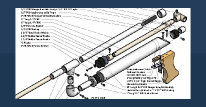Auto-tommy 20, a few simple mods, now gets 2 shots per second ROF and 45-50 foot ranges. Read on for the how and why.
OK, before I begin with this post I just want to say that I have already been trying some of these ideas out, and they seem valid enough. I know many people here dislike flywheel guns for the reasons that they are obnoxiously loud, not terribly accurate, and get poor ranges. I have been experimenting with an automatic Tommy 20 for a bit just to see what I could do to it, since it was laying around collecting dust. Here are some things I came up with:
First, the over-voltage trick that everyone knows about: I selected about 7 volts for my modification because I had a 7.2 volt cheap-o RC car battery laying around which was also collecting dust. When installing it I noticed some interesting things about the internals of the Tommy 20. On the negative terminal of the battery holder there are a pair of capacitors. These are used for two things: soft starting and over-drive protection. Now, at 7 volts the capacitor for the flywheel motors seems to eventually go into a "thermal runaway" state and limit current to the flywheels, slowing them down. So I removed that one. But I left the capacitor for the carousel-advance mechanism because it doesn't seem to have over draw problems when running at 7 volts. Also, the capacitor helps to prevent having the motor jerk so violently when the trigger is pulled all the way down and the firing mechanism is engaged. The added jerk of not having the capacitor in there seems to be doing bad things to the mechanism, and can jar the carousel and cause darts to get unseated, jamming the gun.
I tried using 9 volts, as many people here do, and found that while the flywheels did indeed spin faster, the firing mechanism was simply being put under too much strain. 7 volts is more than enough for me, and seems to put much less strain on the mechanism. At 7 volts the rate of fire increases to almost 2 shots per second, and everything seems to work comfortably. 9 volts has an even better ROF, but can have problems with the carousel mechanism skipping forward too quickly for the darts to be removed from the carousel by the flywheels, resulting in massive jams. If I were to use a 9 volt power source I would probably add some kind of simple resistor pack or potentiometer to reduce the speed of the firing mechanism while getting the advantage of the higher speed flywheels.
Speaking of jams, I noticed that in the entry to the flywheel area there is a small rubber tab sticking down. I did notice that at 7 volts with the tab still in there I would sometimes get jams, and without the tab there were no jams. However, the tab seems to be intended to help center the dart and make sure it enters straight. Without the tab jams don't ever occur, but accuracy seems to suffer significantly.
I also noticed that, for a dart to fly straight when picked up by the flywheels it is critical that the head of the dart be gripped by both wheels at the same time. The wheels, however, are covered in ridges. These might help improve grip, but it would seem that at higher speeds all it does is make it so that if the ridges are un-aligned then one wheel or the other will grab the dart head first, resulting in darts which fly out of the gun at strange angles. I have been experimenting with covering the flywheels in various things, including rubber bands, e-tape, and duct tape. I may experiment with "plasti-dip" as well. Adding a conformal coating of that kind seems to help accuracy a good deal. (straight darts with properly aligned heads are more important) I have noticed that adding enough thickness to the wheels allows them to grip the shaft of the dart as well as the head, vastly improving accuracy and the speed at which the dart exits the flywheels. However, this also can result in the destruction of darts with normal heads, since they get violently crushed and pulled by the flywheels.
Perhaps the best performance I have gotten so far is with darts with low profile heads and solid shafts. A streamline, cut down slightly and with a straw inside for more stiffness, seems to fire very nicely with thicker flywheels, and a long stefan fires very well too. Regardless of what kind of flywheel/dart combination I use, at 7 volts I am getting an average of 45-50 feet flat with an ROF of around 2 shots per second. Stock darts seem to be highly erratic, and will basically go everywhere except where you point the gun. Modded streamlines and stefans with a thicker set of flywheels fly much straighter.
Since I was having problems with side-to-side deviation of darts I decided to experiment with re-aligning the flywheels. Re-centering them on the stock motors is nearly impossible, as removing them and putting them back on tends to only make the alignment problems worse. However, I noticed that there is little angular deviation up or down. (though some up/down variation is caused by the varying speeds that the darts can exit the flywheels.) So I decided to try rotating the flywheel assembly 90 degrees. I haven't permanently attached the flywheels in that fashion as it's simply too cumbersome to do right now, but did notice it decreased the side-to-side deviation significantly, while making the range of each shot more uncertain than before.
Perhaps the biggest problem I have with this gun is how temperamental it can be with different types of ammo. With properly formed stefans of the correct length it's a joy to use: an inaccurate, noisy monster that can lay down a short to medium range wall of foam in a big hurry. Of course in a war situation it's almost impossible to ensure you'll always have stefans of exactly the right length. So if I ever used it in a war at all it'd be used as a somewhat bulky secondary (perhaps with a sling?) for when I'm getting rushed or with integrations. The shell has a decent amount of space that could be used effectively for an integration. Given that I paid nothing for this gun, I find that it does improve significantly with the 4 simple mods I did: increasing voltage, removing only one of the capacitors, removing the rubber tab in the flywheel entry, and thickening the flywheels.
Edited by arfink, 20 December 2010 - 05:23 PM.













